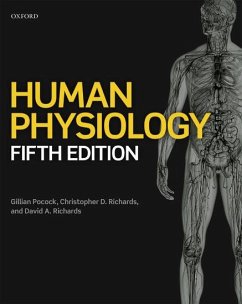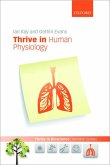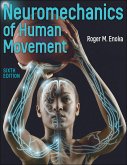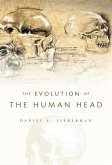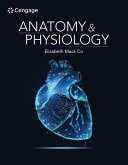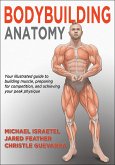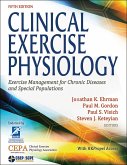Gillian Pocock (Senior Lecture Senior Lecturer in Clinical Science, Christopher D. Richards (Emeritus Professor of Experimental Physiol, David A. Richards (Associate Professor, Associate Professor, Depart
Human Physiology
Gillian Pocock (Senior Lecture Senior Lecturer in Clinical Science, Christopher D. Richards (Emeritus Professor of Experimental Physiol, David A. Richards (Associate Professor, Associate Professor, Depart
Human Physiology
- Broschiertes Buch
- Merkliste
- Auf die Merkliste
- Bewerten Bewerten
- Teilen
- Produkt teilen
- Produkterinnerung
- Produkterinnerung
Human Physiology provides clear explanations of the principles that govern the body's physiological processes and shows how these can be applied. This is the ideal course companion for any student needing a solid foundation in the subject for a future career in human biology, biomedical science, or medicine.
Andere Kunden interessierten sich auch für
![Thrive in Human Physiology Thrive in Human Physiology]() Ian Kay (Associate Head of School, Associate Head of School, SchoolThrive in Human Physiology48,99 €
Ian Kay (Associate Head of School, Associate Head of School, SchoolThrive in Human Physiology48,99 €![Neuromechanics of Human Movement Neuromechanics of Human Movement]() Roger M. EnokaNeuromechanics of Human Movement129,99 €
Roger M. EnokaNeuromechanics of Human Movement129,99 €![Evolution of the Human Head Evolution of the Human Head]() Daniel E. LiebermanEvolution of the Human Head50,99 €
Daniel E. LiebermanEvolution of the Human Head50,99 €![Anatomy & Physiology Anatomy & Physiology]() Elizabeth Co (Boston University)Anatomy & Physiology260,99 €
Elizabeth Co (Boston University)Anatomy & Physiology260,99 €![Bodybuilding Anatomy Bodybuilding Anatomy]() Michael IsraetelBodybuilding Anatomy27,99 €
Michael IsraetelBodybuilding Anatomy27,99 €![Clinical Exercise Physiology Clinical Exercise Physiology]() Clinical Exercise Physiology128,99 €
Clinical Exercise Physiology128,99 €![Human Growth and Development Human Growth and Development]() Human Growth and Development124,99 €
Human Growth and Development124,99 €-
-
-
Human Physiology provides clear explanations of the principles that govern the body's physiological processes and shows how these can be applied. This is the ideal course companion for any student needing a solid foundation in the subject for a future career in human biology, biomedical science, or medicine.
Hinweis: Dieser Artikel kann nur an eine deutsche Lieferadresse ausgeliefert werden.
Hinweis: Dieser Artikel kann nur an eine deutsche Lieferadresse ausgeliefert werden.
Produktdetails
- Produktdetails
- Verlag: Oxford University Press
- 5 Revised edition
- Seitenzahl: 944
- Erscheinungstermin: 7. Dezember 2017
- Englisch
- Abmessung: 277mm x 222mm x 40mm
- Gewicht: 2032g
- ISBN-13: 9780198737223
- ISBN-10: 019873722X
- Artikelnr.: 49666925
- Herstellerkennzeichnung
- Libri GmbH
- Europaallee 1
- 36244 Bad Hersfeld
- gpsr@libri.de
- Verlag: Oxford University Press
- 5 Revised edition
- Seitenzahl: 944
- Erscheinungstermin: 7. Dezember 2017
- Englisch
- Abmessung: 277mm x 222mm x 40mm
- Gewicht: 2032g
- ISBN-13: 9780198737223
- ISBN-10: 019873722X
- Artikelnr.: 49666925
- Herstellerkennzeichnung
- Libri GmbH
- Europaallee 1
- 36244 Bad Hersfeld
- gpsr@libri.de
Gillian Pocock read Physiology at the University of Oxford before moving to Kings' College London to study for her PhD under the supervision of P.F. Baker. She held a post-doctoral position at Kings' College before taking up an appointment in the Department of Physiology, Royal Free Hospital School of Medicine. She is now Senior Lecturer in Clinical Science in the School of Nursing at Canterbury Christ Church University, UK. Her research interests have focussed on the role of calcium in secretion and pH regulation in neurons. Christopher Richards read Biological Chemistry at the University of Bristol. He completed his PhD in the Department of Zoology, University of Bristol, under the supervision of P.C. Caldwell before taking up a position at the Institute of Psychiatry in London. He subsequently moved to the National Institute for Medical Research where he was a member of the scientific staff. He later held posts in the Departments of Physiology at the Royal Free Hospital School of Medicine and University College London where he is currently Emeritus Professor of Experimental Physiology. He has published over 100 scientific articles, chiefly on the physiology and pharmacology of nerve cells. David Richards studied biochemistry at the University of Bristol before beginning his PhD at the National Institute for Medical Research and University College, London under the supervision of T.V.P. Bliss. After postdoctoral positions at the University of Colorado School of Medicine, the University of Zurich Brain Research Institute and the University of Wisconsin School of Medicine, he was appointed Assistant Professor at the University of Cincinnati College of Medicine, before moving to Cincinnati Children's Hospital Medical Center. He is now Associate Professor of Neuropharmacology at Husson University School of Pharmacy in Maine. His research focuses on the cell biology that supports synaptic transmission.
Section 1 Basic concepts in physiology
1: What is physiology?
2: Key concepts in chemistry
3: The chemical constitution of the body
Section 2 The organization and basic functions of cells
4: Introducing cells and tissues
5: The transport functions of the plasma membrane
6: Principles of cell signalling
Section 3 The excitable tissues - nerve and muscle
7: Nerve cells and their connections
8: Muscle
Section 4 The nervous system and special senses
9: Introduction to the nervous system
10: The physiology of motor systems
11: The autonomic nervous system
12: General principles of sensory physiology
13: The somatosensory system
14: The eye and visual pathways
15: The ear and auditory pathways
16: The vestibular system and the sense of balance
17: The chemical senses - smell and taste
18: Emotion, learning and memory
19: The cerebral cortex, sleep and circadian rhythms
Section 5 The endocrine system
20: Introduction to the endocrine system
21: The pituitary gland and hypothalamus
22: The thyroid and parathyroid glands
23: The adrenal glands
24: The endocrine pancreas and regulation of plasma glucose
Section 6 Blood and the immune system
25: The properties of blood
26: Defence against infection: the immune system
Section 7 The cardiovascular system
27: Introduction to the cardiovascular system
28: The heart
29: The electrocardiogram (ECG)
30: The circulation
31: The microcirculation and lymphatic system
Section 8 The respiratory system
32: Introduction to the respiratory system
33: The mechanics of breathing
34: Alveolar ventilation and blood gas exchange
35: The control of respiration
36: Pulmonary defence mechanisms and common disorders of respiration
37: The physiology of high altitude and diving
38: The physiology of exercise
Section 9 The regulation of the internal environment
39: The renal system
40: Fluid and electrolyte balance
41: Acid-base balance
42: The skin and thermoregulation
Section 10 The gastrointestinal system
43: Introduction to gastrointestinal system
44: The gastrointestinal tract
45: The liver and gall bladder
46: Nutrition and the regulation of food intake
47: Energy balance and the control of metabolic rate
Section 11 Reproduction and growth
48: The physiology of the male and female reproductive systems
49: Fertilization, pregnancy, and lactation
50: Fetal and neonatal physiology
51: The physiology of bone and the control of growth
Appendix 1 - Glossary of key terms
Appendix 2 - SI Units
1: What is physiology?
2: Key concepts in chemistry
3: The chemical constitution of the body
Section 2 The organization and basic functions of cells
4: Introducing cells and tissues
5: The transport functions of the plasma membrane
6: Principles of cell signalling
Section 3 The excitable tissues - nerve and muscle
7: Nerve cells and their connections
8: Muscle
Section 4 The nervous system and special senses
9: Introduction to the nervous system
10: The physiology of motor systems
11: The autonomic nervous system
12: General principles of sensory physiology
13: The somatosensory system
14: The eye and visual pathways
15: The ear and auditory pathways
16: The vestibular system and the sense of balance
17: The chemical senses - smell and taste
18: Emotion, learning and memory
19: The cerebral cortex, sleep and circadian rhythms
Section 5 The endocrine system
20: Introduction to the endocrine system
21: The pituitary gland and hypothalamus
22: The thyroid and parathyroid glands
23: The adrenal glands
24: The endocrine pancreas and regulation of plasma glucose
Section 6 Blood and the immune system
25: The properties of blood
26: Defence against infection: the immune system
Section 7 The cardiovascular system
27: Introduction to the cardiovascular system
28: The heart
29: The electrocardiogram (ECG)
30: The circulation
31: The microcirculation and lymphatic system
Section 8 The respiratory system
32: Introduction to the respiratory system
33: The mechanics of breathing
34: Alveolar ventilation and blood gas exchange
35: The control of respiration
36: Pulmonary defence mechanisms and common disorders of respiration
37: The physiology of high altitude and diving
38: The physiology of exercise
Section 9 The regulation of the internal environment
39: The renal system
40: Fluid and electrolyte balance
41: Acid-base balance
42: The skin and thermoregulation
Section 10 The gastrointestinal system
43: Introduction to gastrointestinal system
44: The gastrointestinal tract
45: The liver and gall bladder
46: Nutrition and the regulation of food intake
47: Energy balance and the control of metabolic rate
Section 11 Reproduction and growth
48: The physiology of the male and female reproductive systems
49: Fertilization, pregnancy, and lactation
50: Fetal and neonatal physiology
51: The physiology of bone and the control of growth
Appendix 1 - Glossary of key terms
Appendix 2 - SI Units
Section 1 Basic concepts in physiology
1: What is physiology?
2: Key concepts in chemistry
3: The chemical constitution of the body
Section 2 The organization and basic functions of cells
4: Introducing cells and tissues
5: The transport functions of the plasma membrane
6: Principles of cell signalling
Section 3 The excitable tissues - nerve and muscle
7: Nerve cells and their connections
8: Muscle
Section 4 The nervous system and special senses
9: Introduction to the nervous system
10: The physiology of motor systems
11: The autonomic nervous system
12: General principles of sensory physiology
13: The somatosensory system
14: The eye and visual pathways
15: The ear and auditory pathways
16: The vestibular system and the sense of balance
17: The chemical senses - smell and taste
18: Emotion, learning and memory
19: The cerebral cortex, sleep and circadian rhythms
Section 5 The endocrine system
20: Introduction to the endocrine system
21: The pituitary gland and hypothalamus
22: The thyroid and parathyroid glands
23: The adrenal glands
24: The endocrine pancreas and regulation of plasma glucose
Section 6 Blood and the immune system
25: The properties of blood
26: Defence against infection: the immune system
Section 7 The cardiovascular system
27: Introduction to the cardiovascular system
28: The heart
29: The electrocardiogram (ECG)
30: The circulation
31: The microcirculation and lymphatic system
Section 8 The respiratory system
32: Introduction to the respiratory system
33: The mechanics of breathing
34: Alveolar ventilation and blood gas exchange
35: The control of respiration
36: Pulmonary defence mechanisms and common disorders of respiration
37: The physiology of high altitude and diving
38: The physiology of exercise
Section 9 The regulation of the internal environment
39: The renal system
40: Fluid and electrolyte balance
41: Acid-base balance
42: The skin and thermoregulation
Section 10 The gastrointestinal system
43: Introduction to gastrointestinal system
44: The gastrointestinal tract
45: The liver and gall bladder
46: Nutrition and the regulation of food intake
47: Energy balance and the control of metabolic rate
Section 11 Reproduction and growth
48: The physiology of the male and female reproductive systems
49: Fertilization, pregnancy, and lactation
50: Fetal and neonatal physiology
51: The physiology of bone and the control of growth
Appendix 1 - Glossary of key terms
Appendix 2 - SI Units
1: What is physiology?
2: Key concepts in chemistry
3: The chemical constitution of the body
Section 2 The organization and basic functions of cells
4: Introducing cells and tissues
5: The transport functions of the plasma membrane
6: Principles of cell signalling
Section 3 The excitable tissues - nerve and muscle
7: Nerve cells and their connections
8: Muscle
Section 4 The nervous system and special senses
9: Introduction to the nervous system
10: The physiology of motor systems
11: The autonomic nervous system
12: General principles of sensory physiology
13: The somatosensory system
14: The eye and visual pathways
15: The ear and auditory pathways
16: The vestibular system and the sense of balance
17: The chemical senses - smell and taste
18: Emotion, learning and memory
19: The cerebral cortex, sleep and circadian rhythms
Section 5 The endocrine system
20: Introduction to the endocrine system
21: The pituitary gland and hypothalamus
22: The thyroid and parathyroid glands
23: The adrenal glands
24: The endocrine pancreas and regulation of plasma glucose
Section 6 Blood and the immune system
25: The properties of blood
26: Defence against infection: the immune system
Section 7 The cardiovascular system
27: Introduction to the cardiovascular system
28: The heart
29: The electrocardiogram (ECG)
30: The circulation
31: The microcirculation and lymphatic system
Section 8 The respiratory system
32: Introduction to the respiratory system
33: The mechanics of breathing
34: Alveolar ventilation and blood gas exchange
35: The control of respiration
36: Pulmonary defence mechanisms and common disorders of respiration
37: The physiology of high altitude and diving
38: The physiology of exercise
Section 9 The regulation of the internal environment
39: The renal system
40: Fluid and electrolyte balance
41: Acid-base balance
42: The skin and thermoregulation
Section 10 The gastrointestinal system
43: Introduction to gastrointestinal system
44: The gastrointestinal tract
45: The liver and gall bladder
46: Nutrition and the regulation of food intake
47: Energy balance and the control of metabolic rate
Section 11 Reproduction and growth
48: The physiology of the male and female reproductive systems
49: Fertilization, pregnancy, and lactation
50: Fetal and neonatal physiology
51: The physiology of bone and the control of growth
Appendix 1 - Glossary of key terms
Appendix 2 - SI Units

